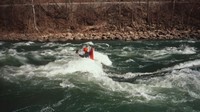 Waves are some of the most fun features on white water runs. Many that are new to whitewater simply love bombing down wave trains. More advanced boaters love to surf waves. They match gravity on the upstream side of the wave against the downstream current and hang on for a wild ride. This next video shows wave surfing technique from a board surfer perspective: Board Surfing Wave Technique. In a kayak, we can carve back and forth with stern draws and sometimes leaning the boat on edge. Here is a real master at wave surfing in kayaks and canoes: New River Dries. A wave is caused by a constriction in the river and a drop over a ledge. Waves are for the most part quite safe. Reactionary waves are caused by the river ricocheting off the side of the river. A great technique in large waves is to maintain a steady paddling cadence and boat scout at the top of the waves. For the most part, the easiest ride is perpendicular to the wave front. The picture on the right is Ender Wave on the New River Gorge.
Waves are some of the most fun features on white water runs. Many that are new to whitewater simply love bombing down wave trains. More advanced boaters love to surf waves. They match gravity on the upstream side of the wave against the downstream current and hang on for a wild ride. This next video shows wave surfing technique from a board surfer perspective: Board Surfing Wave Technique. In a kayak, we can carve back and forth with stern draws and sometimes leaning the boat on edge. Here is a real master at wave surfing in kayaks and canoes: New River Dries. A wave is caused by a constriction in the river and a drop over a ledge. Waves are for the most part quite safe. Reactionary waves are caused by the river ricocheting off the side of the river. A great technique in large waves is to maintain a steady paddling cadence and boat scout at the top of the waves. For the most part, the easiest ride is perpendicular to the wave front. The picture on the right is Ender Wave on the New River Gorge.
Waves have troughs (the bottom) and crests (the tops). Waves can be somewhat smooth and have a glassy appearance. These types of waves are very easy to surf on. Waves can also be quite steep and unstable. Steep waves are fun for performing tricks like enders (driving your boat into the trough to make it shoot back out and go airborn). If a wave is too steep, it will fold back on itself forming a wave hole or exploding wave. These types of waves can be real tricky to run as their height changes frequently. The big difference between a river wave and an ocean wave is river waves are stationary and the water runs though them. Ocean waves move and the water goes along for the ride. If you flip on a river wave, you head downstream and over many more waves - the river current carries you along for the ride. The following video provides an excellent example of this: Hermit Rapid Grand Canyon.
From a safety perspective, waves are usually benign. One safety challenge, large waves definitely impede visability downstream. When running waves, keep a very active paddle in the water as this acts as a good brace. I also recommend scouting from wave tops and initiating turns at the top as well. Make certain you can clearly differentiate waves from large holes which can indeed be quite dangerous. When paddling big water, a solid whitewater roll is essential and swims can be very long and exhausting.
